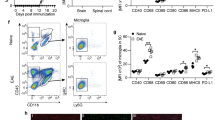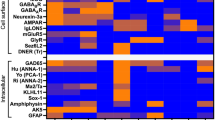Abstract
Clinical improvement during pregnancy in multiple sclerosis (MS) patients suggests that sex hormones exert potent regulatory effects on autoimmune function. Our previous studies demonstrated that estrogen- (17β-estradiol; E2) mediated protection against experimental autoimmune encephalomyelitis (EAE), a mouse model for MS, hinges on the B cells, leading to elevated numbers of IL-10 secreting CD1dhiCD5+ B regulatory cells (Bregs) in wild type mice. Our data show that co-administration of E2 and IL-10+ B cells ameliorates EAE disease severity and limits CNS infiltrating leukocytes in B cell deficient mice. Additionally, treatment with E2 and Bregs reduces demyelination and dramatically decreases the proportion of CD11b+CD45hi activated microglia/macrophages found in the CNS of immunized animals compared to vehicle, E2 or Breg cells alone. Furthermore, mice given E2 and Bregs exhibit increased numbers of peripheral programmed death-1 positive CD4+Foxp3+ regulatory T cells (Tregs) and up-regulation of programmed death receptor-ligand-1 and CD80 expression on monocytes. Our study suggests IL-10 producing Bregs have powerful therapeutic potential as an agent against EAE when augmented with E2 treatment.






Similar content being viewed by others
References
Abramsky O (1994) Pregnancy and multiple sclerosis. Ann Neurol 36(Suppl):S38–S41
Becher B, Antel JP (1996) Comparison of phenotypic and functional properties of immediately ex vivo and cultured human adult microglia. Glia 18:1–10. doi:10.1002/(SICI)1098-1136(199609)18:1<1::AID-GLIA1>3.0.CO;2-6
Bettelli E, Baeten D, Jager A, Sobel RA, Kuchroo VK (2006) Myelin oligodendrocyte glycoprotein-specific T and B cells cooperate to induce a Devic-like disease in mice. J Clin Invest 116:2393–2402. doi:10.1172/JCI28334
Blair PA, Norena LY, Flores-Borja F, Rawlings DJ, Isenberg DA, Ehrenstein MR, Mauri C (2010) CD19(+)CD24(hi)CD38(hi) B cells exhibit regulatory capacity in healthy individuals but are functionally impaired in systemic Lupus Erythematosus patients. Immunity 32:129–140. doi:10.1016/j.immuni.2009.11.009
Bodhankar S, Wang C, Vandenbark AA, Offner H (2011) Estrogen-induced protection against experimental autoimmune encephalomyelitis is abrogated in the absence of B cells. Eur J Immunol 41:1165–1175. doi:10.1002/eji.201040992
Bodhankar S, Vandenbark AA, Offner H (2012) Oestrogen treatment of experimental autoimmune encephalomyelitis requires 17beta-oestradiol-receptor-positive B cells that up-regulate PD-1 on CD4+ Foxp3+ regulatory T cells. Immunology 137:282–293. doi:10.1111/imm.12013
Bodhankar S, Chen Y, Vandenbark AA, Murphy SJ, Offner H (2013a) IL-10-producing B-cells limit CNS inflammation and infarct volume in experimental stroke. Metab Brain Dis 28:375–386. doi:10.1007/s11011-013-9413-3
Bodhankar S, Galipeau D, Vandenbark AA, Offner H (2013b) PD-1 interaction with PD-L1 but not PD-L2 on B-cells mediates protective effects of estrogen against EAE. J Clin Cel Immunol 4:143. doi:10.4172/2155-9899.1000143
Campanella M, Sciorati C, Tarozzo G, Beltramo M (2002) Flow cytometric analysis of inflammatory cells in ischemic rat brain. Stroke 33:586–592
Carson MJ (2002) Microglia as liaisons between the immune and central nervous systems: functional implications for multiple sclerosis. Glia 40:218–231. doi:10.1002/glia.10145
Chabot S, Yong VW (2000) Interferon beta-1b increases interleukin-10 in a model of T cell-microglia interaction: relevance to MS. Neurology 55:1497–1505
Compston A, Coles A (2008) Multiple sclerosis. Lancet 372:1502–1517. doi:10.1016/S0140-6736(08)61620-7
Confavreux C, Hutchinson M, Hours MM, Cortinovis-Tourniaire P, Moreau T (1998) Rate of pregnancy-related relapse in multiple sclerosis. Pregnancy in multiple sclerosis group. N Engl J Med 339:285–291. doi:10.1056/NEJM199807303390501
Daumer M, Weinshenker BG, Voskuhl R (2012) Pregnancy: a “modifiable” risk factor in MS? Neurology 78:846–848. doi:10.1212/WNL.0b013e31824d1858
Duddy M et al (2007) Distinct effector cytokine profiles of memory and naive human B cell subsets and implication in multiple sclerosis. J Immunol 178:6092–6099
Evans JG, Chavez-Rueda KA, Eddaoudi A, Meyer-Bahlburg A, Rawlings DJ, Ehrenstein MR, Mauri C (2007) Novel suppressive function of transitional 2 B cells in experimental arthritis. J Immunol 178:7868–7878
Fillatreau S, Sweenie CH, McGeachy MJ, Gray D, Anderton SM (2002) B cells regulate autoimmunity by provision of IL-10. Nat Immunol 3:944–950. doi:10.1038/ni833
Iwata Y et al (2011) Characterization of a rare IL-10-competent B-cell subset in humans that parallels mouse regulatory B10 cells. Blood 117:530–541. doi:10.1182/blood-2010-07-294249
Kalampokis I, Yoshizaki A, Tedder TF (2013) IL-10-producing regulatory B cells (B10 cells) in autoimmune disease Arthritis research & therapy 15 Suppl 1:S1 doi:10.1186/ar3907
Linington C, Bradl M, Lassmann H, Brunner C, Vass K (1988) Augmentation of demyelination in rat acute allergic encephalomyelitis by circulating mouse monoclonal antibodies directed against a myelin/oligodendrocyte glycoprotein. Am J Pathol 130:443–454
Lyons JA, San M, Happ MP, Cross AH (1999) B cells are critical to induction of experimental allergic encephalomyelitis by protein but not by a short encephalitogenic peptide. Eur J Immunol 29:3432–3439. doi:10.1002/(SICI)1521-4141(199911)29:11<3432::AID-IMMU3432>3.0.CO;2-2
Madan R et al (2009) Nonredundant roles for B cell-derived IL-10 in immune counter-regulation. J Immunol 183:2312–2320. doi:10.4049/jimmunol.0900185
Malpass K (2012) Multiple sclerosis: ‘outside-in’ demyelination in MS nature reviews. Neurology 8:61. doi:10.1038/nrneurol.2011.217
Marques KB, Santos LM, Oliveira AL (2006) Spinal motoneuron synaptic plasticity during the course of an animal model of multiple sclerosis. Eur J Neurosci 24:3053–3062. doi:10.1111/j.1460-9568.2006.05184.x
Matsumoto M et al (2014) Interleukin-10-producing plasmablasts exert regulatory function in autoimmune inflammation. Immunity 41:1040–1051. doi:10.1016/j.immuni.2014.10.016
Matsushita T, Yanaba K, Bouaziz JD, Fujimoto M, Tedder TF (2008) Regulatory B cells inhibit EAE initiation in mice while other B cells promote disease progression. J Clin Invest 118:3420–3430. doi:10.1172/JCI36030
Maugh TH 2nd (1977) The EAE model: a tentative connection to multiple sclerosis. Science 195:969–971. doi:10.1126/science.195.4282.969
Mauri C, Bosma A (2012) Immune regulatory function of B cells. Annu Rev Immunol 30:221–241. doi:10.1146/annurev-immunol-020711-074934
Mohrs M, Shinkai K, Mohrs K, Locksley RM (2001) Analysis of type 2 immunity in vivo with a bicistronic IL-4 reporter. Immunity 15:303–311
Nayak D, Roth TL, McGavern DB (2014) Microglia development and function. Annu Rev Immunol 32:367–402. doi:10.1146/annurev-immunol-032713-120240
Offner H, Polanczyk M (2006) A potential role for estrogen in experimental autoimmune encephalomyelitis and multiple sclerosis. Ann N Y Acad Sci 1089:343–372. doi:10.1196/annals.1386.021
Rasmussen S, Wang Y, Kivisakk P, Bronson RT, Meyer M, Imitola J, Khoury SJ (2007) Persistent activation of microglia is associated with neuronal dysfunction of callosal projecting pathways and multiple sclerosis-like lesions in relapsing–remitting experimental autoimmune encephalomyelitis. Brain J Neurol 130:2816–2829. doi:10.1093/brain/awm219
Ray A, Basu S (2014) Regulatory B cells in experimental autoimmune encephalomyelitis (EAE). Methods Mol Biol 1190:243–255. doi:10.1007/978-1-4939-1161-5_17
Rifa’i M, Kawamoto Y, Nakashima I, Suzuki H (2004) Essential roles of CD8 + CD122+ regulatory T cells in the maintenance of T cell homeostasis. J Exp Med 200:1123–1134. doi:10.1084/jem.20040395
Rifa’i M, Shi Z, Zhang SY, Lee YH, Shiku H, Isobe K, Suzuki H (2008) CD8+CD122+ regulatory T cells recognize activated T cells via conventional MHC class I-alphabetaTCR interaction and become IL-10-producing active regulatory cells. Int Immunol 20:937–947. doi:10.1093/intimm/dxn052
Steinman L (2001) Multiple sclerosis: a two-stage disease. Nat Immunol 2:762–764. doi:10.1038/ni0901-762
Subramanian S, Yates M, Vandenbark AA, Offner H (2011) Oestrogen-mediated protection of experimental autoimmune encephalomyelitis in the absence of Foxp3+ regulatory T cells implicates compensatory pathways including regulatory B cells. Immunology 132:340–347. doi:10.1111/j.1365-2567.2010.03380.x
Weber MS et al (2007) Type II monocytes modulate T cell-mediated central nervous system autoimmune disease. Nat Med 13:935–943. doi:10.1038/nm1620
Williams KC, Ulvestad E, Hickey WF (1994) Immunology of multiple sclerosis. Clin Neurosci 2:229–245
Wolf SD, Dittel BN, Hardardottir F, Janeway CA Jr (1996) Experimental autoimmune encephalomyelitis induction in genetically B cell-deficient mice. J Exp Med 184:2271–2278
Yanaba K, Bouaziz JD, Haas KM, Poe JC, Fujimoto M, Tedder TF (2008) A regulatory B cell subset with a unique CD1dhiCD5+ phenotype controls T cell-dependent inflammatory responses. Immunity 28:639–650. doi:10.1016/j.immuni.2008.03.017
Yang R, Cai Z, Zhang Y, Yutzy WH, Roby KF, Roden RB (2006) CD80 in immune suppression by mouse ovarian carcinoma-associated Gr-1+CD11b+myeloid cells. Cancer Res 66:6807–6815. doi:10.1158/0008-5472.CAN-05-3755
Yang M et al (2010) Novel function of B cell-activating factor in the induction of IL-10-producing regulatory B cells. J Immunol 184:3321–3325. doi:10.4049/jimmunol.0902551
Acknowledgments
This work was supported by National Institutes of Health/National Institute of Neurological Disorders and Stroke grant RO1 NS080890. The authors wish to thank Gail Kent for assistance with manuscript preparation and OHSU research cores for histopathology. This material is the result of work supported with resources and the use of facilities at the VA Portland Health Care System, Portland, OR. The contents do not represent the views of the Department of Veterans Affairs or the US government.
Conflict of interest
The authors declare that they have no conflict of interest.
Author information
Authors and Affiliations
Corresponding author
Electronic supplementary material
Below is the link to the electronic supplementary material.
Sup. 1
The activation and pro-inflammatory states of CD4+ T cells in the periphery of μMT−/− mice. Total CD4+ T cells (a), naïve CD4+ T cells (b), effector memory CD4+ T cells (c) central memory CD4+ T cells (d) and IL-17 (e) and IFN-γ (f) were assessed in the spleen. Data are representative from 4 independent experiments consisting of 6 mice per group (mean ± SEM). Statistical analysis was performed with ANOVA followed by Newman-Kuels post hoc test. Significant differences between sample means are indicated (*p ≤ 0.05; **p ≤ 0.01; ***p ≤ 0.001) (GIF 56 kb)
Rights and permissions
About this article
Cite this article
Zhang, J., Lapato, A., Bodhankar, S. et al. Treatment with IL-10 producing B cells in combination with E2 ameliorates EAE severity and decreases CNS inflammation in B cell-deficient mice. Metab Brain Dis 30, 1117–1127 (2015). https://doi.org/10.1007/s11011-015-9661-5
Received:
Accepted:
Published:
Issue Date:
DOI: https://doi.org/10.1007/s11011-015-9661-5




